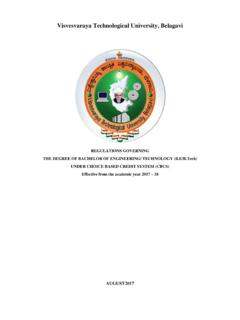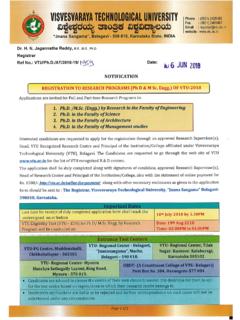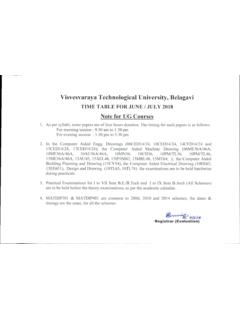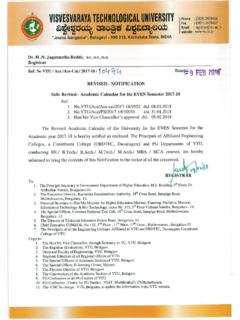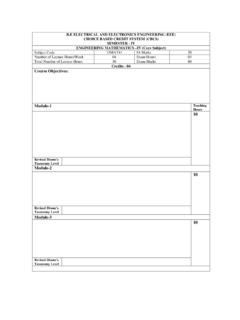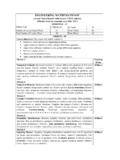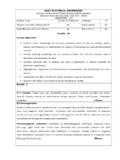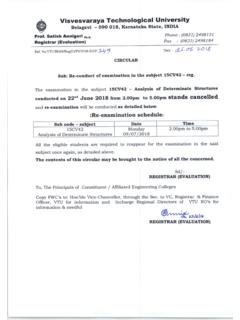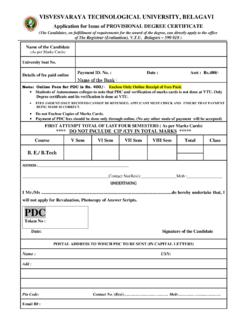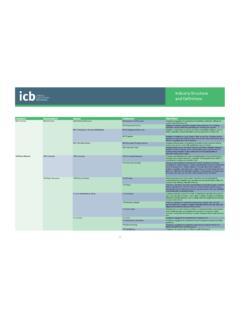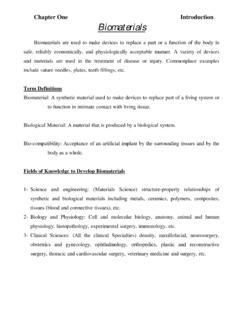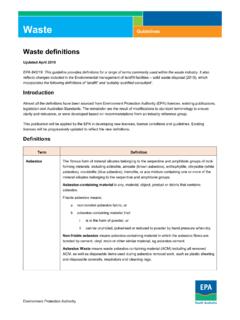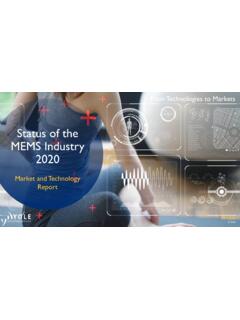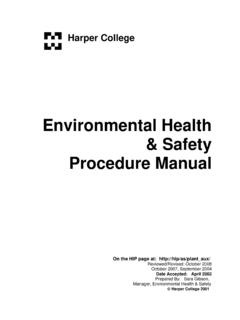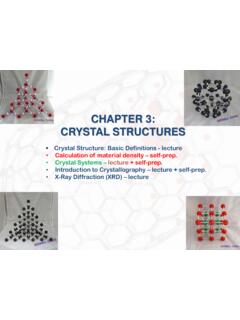Transcription of ELEMENTS OF MECHANICAL ENGINEERING
1 JBOS / EC Page 1 of 5 ELEMENTS OF MECHANICAL ENGINEERING Course Code 21 EME15/25 CIE Marks 50 Teaching Hour/Week (L: T:P:S) 2:0:2:0 SEE Marks 50 Total Hours of Teaching-Learning 40 Total Marks 100 Credits 03 Exam Hours 03 Course Learning Objectives: The course will enable the students to CLO 1. Acquire a basic understanding role of MECHANICAL ENGINEERING in the industry and society CLO 2. Acquire a basic understanding of the formation of steam and its industrial application. CLO 3. Acquire a basic understanding of renewable energy resources and basic concepts of Hydraulic turbines. CLO 4. Acquire knowledge of various ENGINEERING materials and metal joining techniques.
2 CLO 5. Acquire essential experience with heat transfer devices. CLO 6. Acquire knowledge on automobile technology in transport application and basics of Refrigeration and Air-Conditioning. CLO 7. Acquire essential experience on basic Power transmission systems, including MECHANICAL linkages. CLO 8. Acquire knowledge of basic concepts on manufacturing principles and machine tools and their advancement. Teaching-Learning Process (General Instruction): 1. Adopt different types of teaching methods to develop the outcomes through PowerPoint presentations and Video demonstrations or Simulations. 2. Chalk and Talk method for Problem Solving.
3 3. Arrange visits to show the live working models other than laboratory topics. 4. Adopt collaborative (Group Learning) Learning in the class. 5. Adopt Problem Based Learning (PBL), which fosters students Analytical skills and develops thinking skills such as evaluating, generalizing, and analyzing information. 6. Conduct Laboratory Demonstrations and Practical Experiments to enhance experiential skills. Module 1 Introduction to MECHANICAL ENGINEERING (Overview only): Role of MECHANICAL ENGINEERING in Industries and Society- Emerging Trends and Technologies in different sectors such as Energy, Manufacturing, Automotive, Aerospace, and Marine sectors and contribute to the GDP.
4 Steam Formation and Application: Formation of steam and thermodynamic properties of steam (Simple Problems using Steam Tables), Applications of steam in industries namely, Sugar industry, Dairy industry, Paper industry, Food processing industry for Heating/Sterilization, Propulsion/Drive, Motive, Atomization, Cleaning, Moisturization, Humidification Energy Sources and Power Plants: Review of energy sources; Construction and working of Hydel power plant, Thermal power plant, Nuclear power plant, Solar power plant, Tidal power plant, Wind power plant. Introduction to basics of Hydraulic turbines and pumps: JBOS / EC Page 2 of 5 Principle and Operation of Hydraulic turbines, namely, Pelton Wheel, Francis Turbine and Kaplan Turbine.
5 Introduction to working of Centrifugal Pump. Laboratory Components: 1. Visit any one Conventional or Renewable Energy Power Plant and prepare a comprehensive report. 2. Demonstration of Components of any one Turbo-machine through Cut Sections. 3. Visit to an Industry using steam for their process and prepare a comprehensive report. Teaching-Learning Process 1. Power-point Presentation, 2. Video demonstration or Simulations, 3. Chalk and Talk are used for Problem Solving (In-general). 4. Laboratory Demonstrations and Practical Experiments Module 2 Properties, Composition, and Industrial Application of ENGINEERING Materials: Metals-Ferrous: Tool steels and stainless steels.
6 Non-ferrous /metals: aluminum alloys. Ceramics- Glass, optical fiber glass, cermets. Composites- Fiber reinforced composites, Metal matrix Composites. Smart materials- Piezoelectric materials, shape memory alloys, semiconductors, and super-insulators. Metal Joining Processes: Soldering, Brazing and Welding: Definitions. Classification and methods of soldering, brazing, and welding. Brief description of arc welding, Oxy-acetylene welding, Introduction to TIG welding and MIG welding. Heat Transfer Applications: Review of modes of Heat Transfer; Automobile Radiators; Condensers and evaporators of refrigeration systems; Cooling of Electrical and Electronic Devices; Active, Passive, and Hybrid Cooling.
7 Laboratory Components 1. One exercise each involving Welding, Soldering, and Brazing. 2. Study oxy-acetylene gas flame structure and its application to gas welding 3. Demonstration of anyone Heat transfer application device and prepare a comprehensive report. Teaching-Learning Process 1. PowerPoint Presentation, 2. Video demonstration or Simulations, 3. Chalk and Talk are used for Problem Solving (In-general). 4. Laboratory Demonstrations and Practical Experiments Module 3 Fundamentals of IC Engines: Review of Internal Combustion Engines, 2-Strokes and 4-Strokes engines, Components and working principles, Application of IC Engines in Power Generation, Agriculture, Marine and Aircraft Propulsion, Automobile.
8 Insight into future mobility technology; Electric and Hybrid Vehicles, Components of Electric and Hybrid Vehicles, Drives and Transmission. Advantages and disadvantages of EVs and Hybrid vehicles. Refrigeration and Air-Conditioning: Principle of refrigeration, Refrigeration effect, Ton of Refrigeration, COP, Refrigerants and their desirable properties. Principles and Operation of Vapor Compression and Vapor absorption refrigeration. Domestic and Industrial Applications of Refrigerator. JBOS / EC Page 3 of 5 Working Principles of Air Conditioning, Classification, and Applications of Air Conditioners.
9 Concept and operation of Centralized air conditioning system, Laboratory Components: 1. Study of Engine Components through Cut Sections 2. Demonstrate Components and Working principles of Domestic Refrigerator and prepare a comprehensive report OR Study/visit any commercial centralized Air-Conditioning unit, understand various components and operations, and prepare a comprehensive report. Teaching-Learning Process 1. PowerPoint Presentation, 2. Chalk and Talk are used for Problem Solving (In-general). 3. Video demonstration or Simulations, 4. Laboratory Demonstrations and Practical Experiments Module 4 MECHANICAL Power Transmission: Gear Drives: Types - spur, helical, bevel, worm and rack and pinion, velocity ratio, Gear Trains and their application: simple and compound Gear Trains, Simple numerical problems on Gear trains involving velocity ratios Belt Drives: Components of belt drive and concept of velocity ratio; Types of belt drives, Flat-Belt Drive, V-Belt Drive and Application of Belt Drives.
10 Simple numerical problems on Belt drives involving velocity ratios, Concept of Chain, Rope drives and their applications Fundamentals of MECHANICAL Linkages: Definitions of Machines and Mechanisms. Applications of linear motion, oscillatory motion, rotary motion, ratchet and latches, clamping, reverse motion, pause and hesitation, loading and unloading Mechanisms. Introduction to Robotics: Robot anatomy, Joints & links, common Robot configurations. Applications of Robotics in Material Handling, Processing, Assembly, and Inspection. Laboratory Components: 1. Demonstration of the machine consists of Gear Trains.
